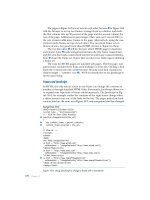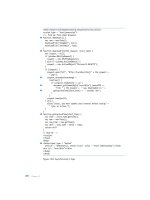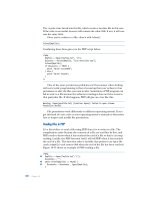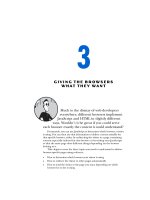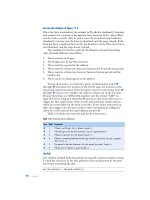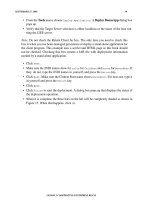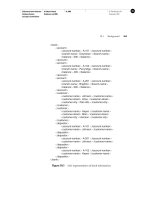Java Server Pages 2nd Edition phần 5 ppsx
Bạn đang xem bản rút gọn của tài liệu. Xem và tải ngay bản đầy đủ của tài liệu tại đây (472.84 KB, 2 trang )
Chapter 14. Working with XML Data
239
var String
No
Optional. The name o
f
the variable to hold the
result as a
org.w3c.dom.
Document
.
scope String
No
Optional. The scope
for the variable; one o
f
page, request,
session, or
application. page
is the default.
The XML document to transform can be specified as the body, as in Example 14-2, or as a
variable through the
xml attribute. The example XML document contains elements
representing information about employees. The xsl attribute is set to the XSL stylesheet
imported by the
<c:import> action. It contains XSLT elements for transforming the XML
document into an HTML table. In Example 14-2, both the
var and the result attributes are
omitted, so the <x:transform> action adds its result to the response. This is the most
common use, but the var and result attributes can be used if the transformation result
needs to be captured and processed further.
Descriptions of all the XSLT elements would fill a book all by itself, but Example 14-3 shows
the stylesheet used here to give you an idea how XSLT looks.
Example 14-3. XSL stylesheet that generates an HTML table (htmltable.xsl)
<?xml version="1.0"?>
<xsl:stylesheet version="1.0"
xmlns:xsl="
<xsl:template match="employees">
<table border="1" width="100%">
<tr>
<th>ID</th>
<th>Employee Name</th>
<th>Phone Number</th>
</tr>
<xsl:for-each select="employee">
<tr>
<td>
<xsl:value-of select="@id"/>
</td>
<td>
<xsl:value-of select="last-name"/>,
<xsl:value-of select="first-name"/>
</td>
<td>
<xsl:value-of select="telephone"/>
</td>
</tr>
</xsl:for-each>
</table>
</xsl:template>
</xsl:stylesheet>
Chapter 14. Working with XML Data
240
The XSLT elements are similar to JSP action elements in that they perform some action rather
than identify information types. The XSLT elements select and process pieces of the source
XML document. Here, the <xsl:template> element selects the top <employees>
element in the source XML document, the <xsl:for-each> element loops over all nested
<employee> elements, and the <xsl:value-of> elements extract the attribute values and
nested elements for each <employee> element. The non-XSLT elements are used as
template data, the same way as in JSP. You get the idea.
An XSLT stylesheet can use parameters to represent dynamic data, provided to the XSLT
processor when a document is transformed:
<?xml version="1.0"?>
<xsl:stylesheet version="1.0"
xmlns:xsl="
<xsl:param name="empName" />
<xsl:template match="employees/employee[name = $empName]">
The parameter in this example limits the <employee> elements to be processed to those that
have a <name> element with the value specified by the parameter.
To pass the parameter value to the XSLT stylesheet, you must use a nested <x:param>
action in the <x:transform> body:
<x:transform xslt="${stylesheet}">
<x:param name="empName" value="${param:empName}" />
<?xml version="1.0" encoding="ISO-8859-1"?>
<employees>
<employee id="123">
<first-name>Hans</first-name>
<last-name>Bergsten</last-name>
<telephone>310-555-1212</telephone>
</employee>
</x:transform>
Here I pass on a request parameter value to the stylesheet, but you can, of course, use any EL
expression as the value.
XML documents, including XSLT stylesheets, can contain references to external entities, for
instance in the XSL
<xsl:include> and <xsl:import> elements. If these references are
written as relative paths in the document, a base URI must be used to establish what they are
relative to. You can pass base URIs for the XSLT stylesheet and the XML source to the
<x:transform> action through the xsltSystemId and the xmlSystemId attributes.
The value can be any valid URI, such as an absolute file or HTTP URL or a context- or page-
relative path.
14.3 Transforming XML into a Device-Dependent Format
A web application can use XSLT to respond with different content depending on the type of
device making the request. Example 14-4 shows a page that serves both HTML and WML
